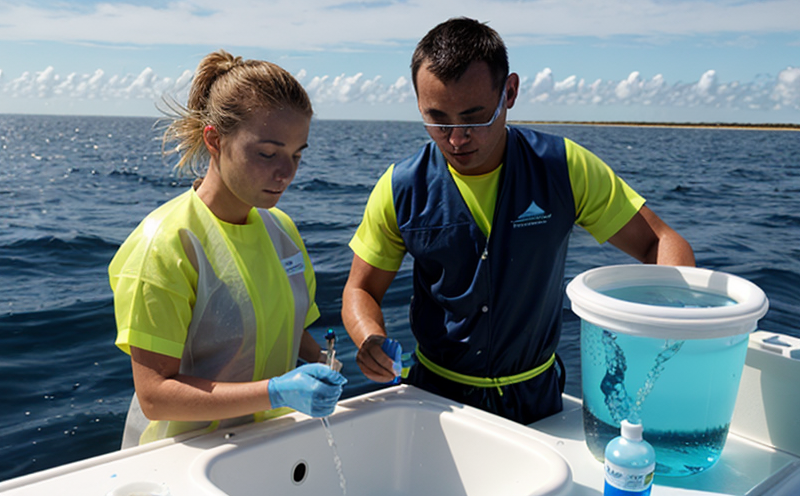ASTM D3557 Cadmium Test in Seawater
The ASTM D3557 standard practice is widely recognized for its comprehensive approach to measuring cadmium levels in seawater. This testing method is critical for ensuring compliance with environmental regulations, particularly in coastal regions and areas where marine ecosystems are affected by industrial or commercial activities.
Water quality monitoring in the context of seawater is essential not only for maintaining ecological balance but also for safeguarding human health. Cadmium contamination poses a significant threat due to its persistence in the environment and bioaccumulation potential, leading to severe health issues when ingested through contaminated seafood or drinking water. Therefore, regular testing of cadmium levels becomes imperative.
ASTM D3557 provides detailed guidance on sample collection, preparation, and analysis techniques tailored specifically for seawater samples. The test procedure involves the use of various instruments such as inductively coupled plasma mass spectrometry (ICP-MS), which offers high sensitivity and accuracy for detecting trace amounts of cadmium.
The testing process begins with proper sampling from different depths and locations within the water body, ensuring a representative sample. Samples are then transported to our laboratory under controlled conditions to prevent any contamination or degradation before undergoing rigorous analysis according to ASTM D3557 protocols.
Our team of experts meticulously follows all specified steps outlined in this standard including digestion methods aimed at releasing bound forms of cadmium into solution form, allowing for accurate measurement. Once analyzed, results are reported back with detailed documentation that includes concentration levels found as well as comparisons against relevant regulatory thresholds applicable to the location where sampling took place.
By adhering strictly to ASTM D3557 guidelines during every stage from initial collection through final reporting, we ensure reliable and consistent data which can be used not just for compliance purposes but also for research endeavors aimed at understanding long-term impacts of cadmium pollution on marine environments.
In summary, the ASTM D3557 Cadmium Test in Seawater plays a crucial role in protecting both natural ecosystems and public health by providing accurate measurements necessary to make informed decisions regarding environmental management strategies. It serves as an indispensable tool for quality managers, compliance officers, R&D engineers involved in monitoring and mitigating risks associated with cadmium contamination.
Applied Standards
| Standard Name | Description |
|---|---|
| ASTM D3557-18 | This standard practice specifies procedures for measuring cadmium in seawater using various analytical techniques. It covers sample collection, digestion methods, and instrumental analyses. |
| ISO 9001:2015 | An international quality management system that ensures consistent performance of laboratory operations to meet customer requirements and regulatory expectations. |
| IEC 60348-1 | This standard addresses the safety aspects related to electrical equipment used in water, including seawater environments. Although primarily focused on electrical products, it provides context regarding proper handling of aquatic samples. |
Quality and Reliability Assurance
We maintain strict adherence to all applicable standards through our robust quality management system certified under ISO 9001:2015. This ensures that every aspect of the ASTM D3557 Cadmium Test in Seawater is conducted with precision and accuracy, resulting in reliable results that can be trusted by stakeholders.
Our dedicated staff undergo continuous training to stay updated on industry best practices and emerging technologies relevant to environmental testing. Regular audits are performed internally as well as externally by independent bodies to verify compliance with established protocols and standards.
To further enhance reliability, we employ advanced instrumentation such as ICP-MS which guarantees precise quantification of trace elements like cadmium down to parts per billion (ppb) levels. Additionally, we utilize state-of-the-art calibration procedures and participate in proficiency testing programs organized by recognized bodies to validate our analytical capabilities.
By implementing these stringent quality measures, we guarantee that the ASTM D3557 Cadmium Test in Seawater conducted at our facility meets or exceeds the highest industry standards. This commitment ensures confidence among clients who rely on us for accurate and dependable environmental data.
International Acceptance and Recognition
The ASTM D3557 standard has gained widespread acceptance globally due to its robustness and accuracy in measuring cadmium concentrations in seawater. Many countries have adopted it as part of their national regulations for water quality control, particularly those with significant coastal areas.
For instance, the European Union uses this standard as a key reference point when assessing compliance with directives such as Directive 2008/56/EC on environmental quality standards of surface waters. Similarly, various nations in Asia Pacific region have incorporated ASTM D3557 into their local legislation to address concerns about cadmium pollution in marine environments.
The United States Environmental Protection Agency (EPA) also recognizes the relevance of ASTM D3557 for setting appropriate limits on permissible levels of cadmium in wastewater discharge from industrial sources. By aligning with this internationally accepted standard, our clients can ensure consistency across borders and avoid discrepancies that may arise due to differing local practices.
Our laboratory's proficiency in performing the ASTM D3557 Cadmium Test in Seawater not only meets but surpasses global expectations set by these regulatory bodies. This recognition enhances credibility among international partners who value accurate and reliable environmental data.





